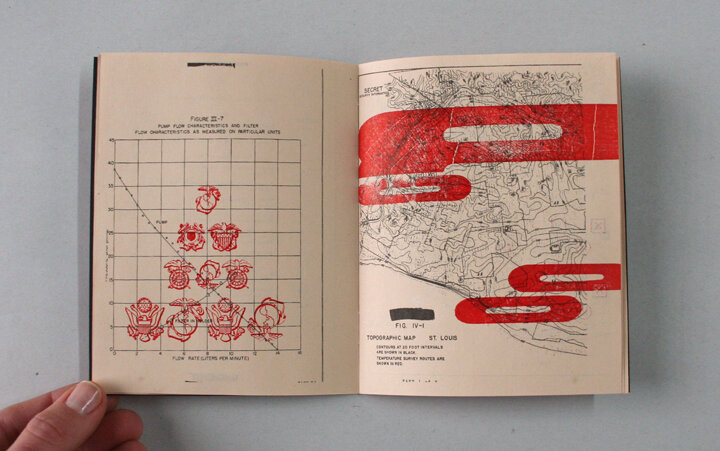Anyone who has followed my work for a while is likely familiar with some of the projects I have done based Dr. Lisa Martino-Taylor’s research of secret, Cold War era radiological weapons tests that were done on the uninformed U.S. populace. In my artwork, I specifically explored a program in which radioactive zinc cadmium sulfide particles were sprayed over targeted low-income, densely populated neighborhoods in St. Louis, Missouri. The scientists (who were formerly part of the Manhattan Project) researched particle dispersal patterns and the effects of radiation exposure on unknowing St. Louis residents.
As the Covid-19 pandemic progressed this year, my mind kept going back to that work, and the strange connections between the themes in those projects and the unfolding events in the world around us. While the artwork about St. Louis has very specific references and context, I now think about present day issues when I look at it. I want to highlight one piece in particular that stands out.
Part 2: Clouds Behaving Badly is a small, letterpress and ink jet printed artist book I made back in 2015 at Spudnik Press in Chicago. To make Part 2: Clouds Behaving Badly, I printed wood type over digitally printed content from a declassified government document titled Behavior of Aerosol Clouds within Cities, which explained the nature of the St. Louis project and how it was carried out. “Part 2” refers to Part 2: Technical Summary, April 1954, an important document with the results of the covert military-scientific aerosol studies that was denied to Dr. Martino-Taylor and is only accessible to government agencies.
Clouds are a major theme in this artist book and other work I have done—a reference to the aerosol clouds that were sprayed over St. Louis, as well as the cloud of deception and coverup. The narratives around how Covid-19 is transmitted made me think of this spread in Part 2: Clouds Behaving Badly:
I have so many questions around these narratives. It is deeply troubling that there have been extensive randomized controlled trial (RCT) studies, and meta-analysis reviews of RCT studies, all determining that masks and respirators do not prevent respiratory illnesses believed to be transmitted by aerosol particles; yet, this research is not being widely discussed. There is a widespread willingness to believe that cotton masks provide protection, when studies have shown even N95 masks, when used correctly, do little (if anything) to prevent the spread of respiratory or influenza-like illnesses. (Are you unsubscribing from my newsletter yet?) In the midst of the mask debate, I mentally return to this book spread again and again, thinking about the inhalation and particulate size in a whole new context.
Another unexpected correlation deals with surveillance and tracking, a subject that is in most of the work I have made since 2014. The above text, “Urban tracer experiment”, which referred to tracking the geographic and biological spread of aerosol particles in an urban area, now looks to me like a contact tracing announcement, complete with charts of new Covid cases skyrocketing. A “tracer experiment” is once again is being carried out on the U.S. populace in the form of contact tracing on our phones, at schools, at places of worship, at businesses, and at work places… virtually everywhere we go. (Here’s an example that made me shudder.) Now the experiment is more or less in plain sight, and it is no longer just the government and scientists tracking us. I am not making an argument here about whether or not contact tracing is an effective way to prevent the spread of Covid-19. I am afraid the pandemic is making people more comfortable with the idea of being tracked all the time by all sorts of entities who supposedly have our safety in mind.
Finally, I will touch on the above book spread, which suggests multiple interesting narratives related to the 2020 experience. The page on the left was originally meant to represent a government and military power structure that uses compartmentalization in order to obfuscate the true nature of its work. That interpretation is still relevant in a pandemic re-reading of this book, but the image also brings to mind a race to the top for a vaccine, the politicization of the pandemic, and the way the election has loomed above the Covid-19 crisis like a cloud this entire year. On the right page, the cartographic imagery relates to all kinds of scenarios: maps of Covid outbreaks, forest fires, hurricanes, power outages, and political party maps. This page spread could stand in for any month in 2020.
There is a fascinating talk on Thy Symbolics World with Jonathan Pageau and Christian Roy, an expert on Jaques Ellul and Marshal Mcluhan. Roy explains Ellul’s philosophy that we live in a technical society, with ever increasing and related systems of chaos and control. As things in the world continue to get more fragmented and disintegrated, there is a simultaneous move towards more control (and less freedom). Technology is not neutral; it transforms us as human beings. Regardless of what political ideology we embrace, we operate in the same model, which is one of technicity and mobilization. In today’s divided political world, I think it is crucial to understand this. I think this is why Part 2: Clouds Behaving Badly relates as much to the Cold War as it does to the present day.
I have heard artists describe the idea of “serving” their artwork, in the sense that in some way the art reveals itself to the artist. The artist cannot fully control how the artwork is interpreted, what the final meaning will be, who it will reach, and what its impact will be in the world. While some artists make their work all about that practice of discovery, I tend to work in a controlled, methodical way, based on research and planning. Even so, my artwork still changes in relation to the world around me, and I discover new meaning in the process.



